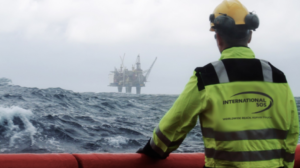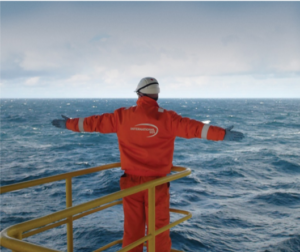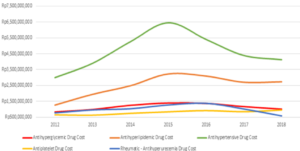Moving beyond safety: the case for health-promoting workplaces
As companies increasingly recognize the importance of a healthy workforce, drilling industry can leverage its existing safety foundation to influence employee behaviors
By Rodrigo Rodriguez-Fernandez, International SOS
The World Health Organization (WHO) has named noncommunicable diseases (NCDs) a global epidemic. NCDs, also known as chronic diseases, kill 41 million people each year, equivalent to 71% of all deaths globally. Over 85% of these “premature” deaths occur in low- and middle-income countries – often places where drilling activities are increasing.
 The main types of NCDs are cardiovascular diseases (like heart attacks and strokes), cancers, chronic respiratory diseases (such as chronic obstructive pulmonary disease and asthma), diabetes and mental health. They tend to be of long duration and result from a combination of genetic, physiological, environmental and behavioral factors.
The main types of NCDs are cardiovascular diseases (like heart attacks and strokes), cancers, chronic respiratory diseases (such as chronic obstructive pulmonary disease and asthma), diabetes and mental health. They tend to be of long duration and result from a combination of genetic, physiological, environmental and behavioral factors.
Both onshore and offshore, there has been a growing number of NCD-related cases, leading to increased medical spending, loss of productivity, impact on reputation and, ultimately, a blow to the triple bottom line. Workplace-based wellbeing – also known as wellness or health promotion – programs can address this challenge by preventing the onset of new cases and improve the lives of those with existing NCD-related conditions.
This article looks at what companies can do to help workers fight against this epidemic. Two case studies will be discussed where health surveillance initiatives and standardized health promotion materials were implemented to improve the health and wellbeing of their workers.
Why the Epidemic?
Of all the major health threats to emerge, none has challenged the very foundations of public health as profoundly as the rise of chronic NCDs. These diseases share four risk factors: tobacco use, the harmful use of alcohol, unhealthy diets and physical inactivity.
Changes in the way people eat, drink, sleep and use transport have a particular importance within the onshore and offshore setting. In an industry where the majority of employees are male, on shift work, away from their families, exposed to unhealthy foods, prone to increased use of tobacco and, in some instances, have low physical activity levels, this creates the perfect storm for NCDs.
However, this was not always the case. Decades ago, workers were at risk of contracting contagious diseases such as malaria, leprosy and tuberculosis. While these threats still remain, they are much smaller than they used to be due to advances in public health.
 In the 19th century, improvements in hygiene, living standards and nutrition were followed by improvements in health technology and life expectancy. This greatly helped to control contagious diseases, eliminating them as major killers from modern societies.
In the 19th century, improvements in hygiene, living standards and nutrition were followed by improvements in health technology and life expectancy. This greatly helped to control contagious diseases, eliminating them as major killers from modern societies.
Today, the tables have turned. As living conditions improve, socioeconomic progress has actually created conditions that favor the rise of NCDs. Economic growth leading to increased access to food and beverage options and urbanization have created a wide entry point for the globalized marketing of health-harming products and the spread of unhealthy lifestyles. At the same time, while the world has 800 million starving people, it also has countries where more than 70% of the adult population is overweight or obese.
Unfortunately, most in the drilling industry have not been spared from these global trends. There is a growing number of medical evacuations, unhealthy trends seen during periodical health checks or pre-deployment health checks, and the age at which disease such as heart attacks are occurring amongst workers is becoming lower.
What can we do about it?
There are two major leverage points that the drilling industry holds over the general population when it comes to health. First, it has a strong foundation, built over many years, of improving safety standards. The desire to improve and maintain these standards has led to the creation of standardized processes and procedures, which can serve as the foundation for a culture that goes beyond safety to include a stronger emphasis on health.
 The second advantage is that it holds a captive population. Drilling contractors, whether onshore or offshore, can engage with workers in remote worksites, which can be used as platforms to improve health and wellbeing.
The second advantage is that it holds a captive population. Drilling contractors, whether onshore or offshore, can engage with workers in remote worksites, which can be used as platforms to improve health and wellbeing.
Through periodic health checks, companies in the drilling industry – particularly in the offshore space – can have a better idea than many other industries of the health status of their workers. Further, they can influence what workers eat, drink and are exposed to in terms of health-promoting information, particularly in the offshore space. Drilling companies can leverage these worksites to play a stronger role in influencing healthy behavior.
The same can also be done with onshore companies, where well-designed workplace programs can introduce measures such as healthy food options, mental resilience building programs, and physical activity enhancing activities.
Synchronized Health Promotion, Education
The WHO has recognized the workplace as a priority setting for health promotion in the 21st century. The workplace directly impacts the physical, mental, economic and social wellbeing of workers and even the health of their families, communities and society. It provides the right setting and infrastructure to look after the health and wellbeing of a large audience.
The idea of a health-promoting workplace (HPW) is becoming more important as a larger number of companies recognize that success in a globalizing marketplace can only be achieved with a healthy, qualified and motivated workforce.
Further, a well-designed health promotion and education program can safeguard a balance between customer expectations and organizational goals on the one hand and worker’s skillsets and health needs on the other.
This, in turn, can give drilling contractors a competitive advantage within the global marketplace. For countries as a whole, the rollout of health promotion and education programs will be a prerequisite for sustainable social and economic development.
Recently, a global health promotion and education program was launched within a large drilling contractor in Latin America and Africa. The program consists of a calendar of health and wellbeing topics that are pre-selected by the medical leadership in the region (to be locally relevant), together with a selection of the appropriate health educational material.
Workplace wellbeing programs that are well planned not only improve the health of workers, but they have also shown to make a return on the initial investment.
These materials include brochures, handouts, presentations and posters and are sent to medical professionals on offshore sites. For guidance, the calendar of topics matches the WHO’s global health days of similar events.
All medical professionals conduct the same health and wellness campaigns on their respective sites at the same period interval and focus on the same health topic on a bimonthly basis. This allows them to cover both those who are currently offshore, as well as the back-to-back workforce.
Standardizing the material and content ensures that a consistent level of knowledge and training is conveyed to the onsite population and allows a fleetwide implementation of health agendas and distribution of new work and lifestyle practices. This methodology has been implemented on rigs operating in the US Gulf of Mexico and West Africa.
An example set of topics include: back pain, ergonomics, healthy eating, skincare, sexual health, hearing conservation, health and hygiene, and infectious illness prevention.
Health Surveillance in Scandinavia
Employee health surveillance is a term used to describe a range of health checks and tests that help identify health risks and improve wellbeing among workers. They have the potential to benefit both individuals and their employers by providing information to the employee about existing health concerns or capture potentially more serious health issues early when they are easier to treat. Lifestyle advice and support provided by routine health surveillance (e.g., advice when someone is overweight or obese) can reap long-term life-enhancing benefits.
 The information collected during health surveillance programs remains confidential the same way a medical consultation would. Employers receive aggregate data with information that tells them how the population is doing as a whole, without any personal details that might single out any individual.
The information collected during health surveillance programs remains confidential the same way a medical consultation would. Employers receive aggregate data with information that tells them how the population is doing as a whole, without any personal details that might single out any individual.
Recently, a large drilling contractor launched a health surveillance program in Scandinavia, with plans to expand to Latin America. The objective of the program was to develop a service within the offshore population that monitored the health and wellbeing of workers.
The program had an emphasis on occupational exposures and included clinical assessment (medical history and physical examination), vital signs, BMI calculation, audiometry, spirometry and urine testing. The first step in this process was to up-skill the offshore medical professionals on how to carry out health surveillance consultations while offshore and introduce them to new occupational health procedures for on-site practice.
The process developed for the implementation of the program was:
1. Define the scope of the program and decide on what parameters to capture.
2. Review legal aspects of the health surveillance program implementation.
3. Review program documentation and operating procedures.
4. Identify certified training programs on the conduct of occupational health surveillance consultations, spirometry and audiometry procedures.
5. Identify providers in country for the recommended medical surveillance equipment and supplies, including the devices for spirometry and audiometry.
6. Roll out the program.
7. Collect the data and report the findings.
What Results can be Expected?
Many workplace wellbeing programs have come under the microscope to figure out if they actually achieve what they are set out to do. Across the board, in all industries and geographical regions, evidence has shown that well-planned programs not only improve the health and wellbeing of the workers, but they also make a return on the initial investment.
It usually takes two to three years to start seeing this return on investment (ROI), which can yield $2-4 per dollar spent. However, programs can start to have an impact on employee health within months. In one project in Southeast Asia in 2014, healthcare spending on heart disease-related drugs started trending downward only months after a workplace wellbeing program started in Q2 of that year.
A successful drilling contractor sees its employees not only as an input to the business but also as an output. Well-performing contractors seek to have workers exiting their workforce happier and healthier than when they joined. The industry has perfected the safety element to drilling. Now, it should increase its focus on NCDs. DC
This article is based on a presentation at the 2019 IADC Drilling HSE&T Europe Conference & Exhibition, 18-19 September, Amsterdam.
Acknowledgements
Thank you to Dr Salwan Ibrahim for providing input on the case studies and to Dr Louise Slaney for providing two of the pictures.




